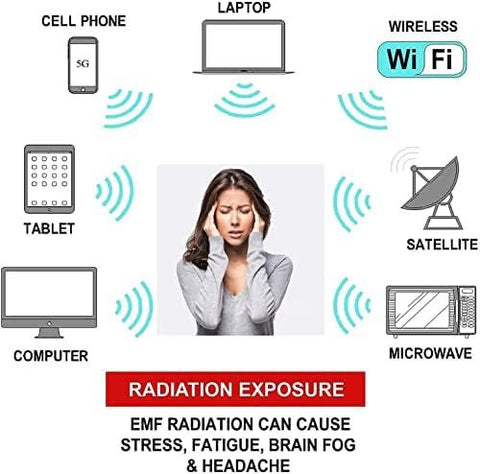
The Top 10 Devices That Emit EMFs & Solutions
In today's tech-driven world, we're surrounded by a plethora of electronic devices, all of which contribute to our convenience and connectivity. However, along with their benefits, there's also an increasing concern about their potential negative health impacts, particularly regarding electromagnetic field (EMF) radiation. While EMF radiation is a natural part of our lives, certain devices amplify it to levels that some worry could be harmful. In this blog, we will dive into which devices emit EMF radiation and what you should know about them.
Most Common Devices Emitting EMF Radiation:
- Cell Phones: Perhaps the most ubiquitous source of EMF radiation in our daily lives, cell phones emit EMFs when transmitting data, making calls, or connecting to Wi-Fi or Bluetooth.
- Wi-Fi Routers: These devices constantly emit EMF radiation to provide wireless internet connectivity to various devices within their range. They are prevalent in most homes and offices.
- Bluetooth Devices: Headsets, speakers, keyboards, and other Bluetooth-enabled gadgets emit EMFs to establish wireless connections with other devices. Just go to the gym on any given day and see 90% of the members hooked up to wireless devices.
- Microwave Ovens: While designed to contain EMFs within their metal casing, microwave ovens emit RF radiation during operation.
- Laptops and Tablets: Portable computing devices like laptops and tablets emit EMFs, particularly when connected to Wi-Fi or Bluetooth.
- Smart Meters: Installed by utility companies to remotely monitor energy usage, smart meters emit RF radiation intermittently.
- Baby Monitors: Baby monitors, especially those with video capabilities, emit RF radiation to transmit audio and video signals between the baby unit and the parent unit.
- Televisions: Smart TVs and older CRT televisions emit EMFs, especially when connected to Wi-Fi or Bluetooth for streaming content.
- Smart Watches: Smartwatches emit low levels of EMFs, primarily in the form of Bluetooth and Wifi signals.
- Virtual Reality: VR headsets potentially expose users to harmful EMF radiation. Their wireless connections utilize Bluetooth or WiFi to connect with smartphones or computers, along with smart sensors that provide an immersive VR experience. Working in tandem with cell phones, providing wireless connectivity means that the VR headsets also emit radiation and could pose long-term health risks.

Assessing the risks:
While there is much debate over the health effects of EMF radiation, some studies suggest potential risks associated with prolonged exposure to EMF radiation. These risks include increased cancer risk, disrupted sleep patterns, and neurological effects. However, the scientific consensus remains inconclusive, with regulatory agencies like the FDA and FCC setting exposure limits based on current research. It’s important to educate yourself about the potential risks and do research.
Mitigating Exposure:
While it's challenging to completely avoid EMF-emitting devices in today's digital age, several measures can help reduce your exposure:
- Use Wired Connections: Whenever possible, opt for wired connections instead of wireless ones. For instance, use Ethernet cables for internet connectivity and wired headphones instead of Bluetooth.
- Keep Devices at a Distance: Maintain a safe distance from devices that emit EMFs, especially when sleeping or during extended use.
- Limit Screen Time: Reduce unnecessary exposure by limiting the use of devices like cell phones, laptops, and tablets, especially before bedtime.
- Use EMF Shielding Products: Consider using EMF shielding products for cell phones, earbuds, and laptops. WaveBlock stickers are lab-tested for the best results and verified to be effective in minimizing exposure to EMFs.

While EMF radiation is a natural phenomenon, the proliferation of electronic devices has raised concerns about the potential health risks associated with prolonged exposure. While the scientific community continues to study the effects of EMFs on human health, it's essential to be aware of which devices emit them and take steps to minimize exposure where possible. By understanding the risks and implementing practical measures to mitigate exposure, we can navigate the digital landscape more safely and responsibly. Study the lab tests published on WaveBlock’s website to learn more.
WaveBlock® samBlock (Androids)

